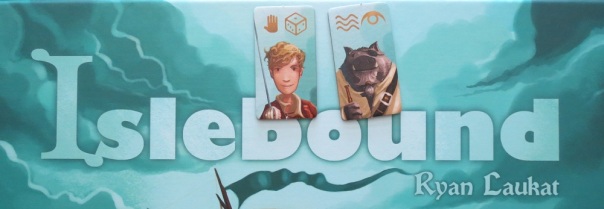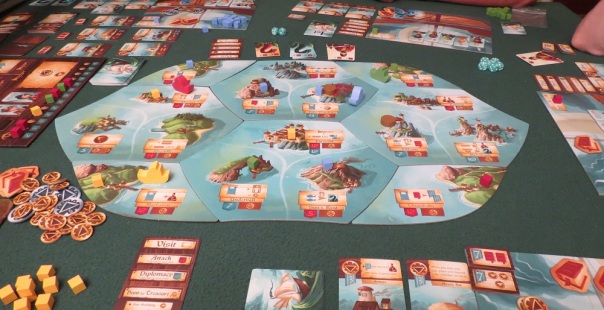We’ll All Float On Okay
If I were forced to identify the unifying “aesthetic” of a Ryan Laukat game — and avoided using actual, you know, aesthetics, the bold colors and whimsical fantasy creations that populate his worlds — it would be that the creator of Red Raven Games has carved a niche out for himself by making games that seem a lot like other games, but look and play almost nothing like anything else. City of Iron announces itself as a cube-pusher and deck-builder, then merges those systems in a way that’s reminiscent of precisely nothing. Eight-Minute Empire is a study in minimalism that avoids feeling restrictive. Even Laukat’s forays into worker placement, The Ancient World and Above and Below — which itself echoes older storytelling games like Tales of the Arabian Nights — step to the beat of their own drummer. It’s almost as though Laukat knows these systems exist, but has only read about them in old newspaper articles or printed-out scraps of blog posts that happened to wash up on his desert island.
And to be clear, that’s a good thing. It’s what makes something like Islebound work so well.
For all its roughness, Islebound is no different. Here’s a game that’s about sailing around an archipelago, seeking commodities and fame and fortune, that doesn’t sport so much as a lick of the pick-up-and-deliver that games about sailing the emerald seas usually emphasize. There’s some minor piratical behavior, but hardly any violence. Treasure hunting, but not of the x-marks-the-spot variety.
Without those, what’s left?
Well, let’s consider what you’ll be doing on an average turn. Firstly, you’ll sail. And don’t think there’s any getting out of it, because this is a game of constant motion. Whether it’s because your crew is restless or you’ve got a wandering heart or that’s just a peculiarity of the trade winds in Laukat’s private universe, there’s no such thing as staying put for more than a turn. There’s also no such thing as sharing space with other ships, at least unless you have one of your shipboard administrators spend the day asking permission. The downside is that asking nicely tuckers them out, sending them belowdecks to recuperate.
Okay, so maybe it’s a game about managing your crew? Sure enough, there’s plenty of that going on. Administrators are useful for negotiating a berth alongside other ships, and certain ports require that you tire someone out before you dock. Fighters need a break after fighting, and anyone can find themselves exhausted if you need that little extra oomph to win a battle. Stopping by friendly ports with a warm bed will get your crew back on their feet. For anyone who played Above and Below, where the beds could be even more critical than gold, the way Islebound handles its personnel will feel immediately familiar.
And yet it’s not much of a worker placement game. It’s possible for a ship to function perfectly well with a skeleton crew, though it might require some clever planning and a bit of juggling. A big crew will make life on the sea easier, but it isn’t always mandatory.
Without that, what’s left?
That’s precisely the question that Islebound is likely to engender, especially among first-time players. See, upon moving, your ship has the option to take a single action. Roughly eighty percent of the time that action will be to visit the port you’ve arrived at, paying the entry fee to the treasure stash and doing whatever that locale instructs. There are ports for resting and ports for gathering fish or timber, ports where you can hire pirates or even friendly sea serpents to help your ship do battle. There’s a port called Farwold where you can brag about your captainly deeds, though with a chance that you’ll also be bragging up other crews at the same time. In Morlim and Undervall, you can recruit new pals to join your crew.
And yet there isn’t any single place where you might drop off fish or timber for profit, no location that desires one commodity over another, no roaming vessels to ransack or governor’s daughters to kidnap. For anyone whose experience of sea life has revolved around games of a particular formula, Islebound does something entirely different.
It certainly doesn’t alleviate this initial sense of confusion that Islebound’s iconography is such a mess. Look no further than Scythe for an example of how to create legible iconography: costs outlined in red, benefits outlined in green, never any confusion about whether you’re paying or receiving. It takes a full game of Islebound to really grasp how each port might help further your goals as a captain, and probably a couple more before the whole thing locks into place and the game’s strategy emerges to the forefront.
See, while you’re busy visiting towns and hiring crew and cramming your hold with way too many fish, somebody else is pursuing missions to earn influence or hiring a ton of pirates. Those people will inevitably descend on towns and capture them, whether by diplomacy or piracy, picking up a huge chest of gold and permanent ownership of that port. Then they’ll use that gold — and the gold they’ll keep earning whenever you visit their new franchise — to purchase buildings back at home.
At first glance, buildings might seem like a bit much. There’s one that gives you an all-consuming super-serpent. Owning a Bank means you never have to pay your own docking fees again, instead just paying a coin from the general supply. There’s a Pirate Headquarters that give you free pirates whenever you stop to search for treasure — which is normally “skipping” a turn in order to pick up some loose pennies — and even a Museum that visitors to your towns are forced to visit, giving you extra renown every time they gaze dully at that life-sized statue of you shaped entirely out of butter.
The thing is, it’s these buildings that give your ship its unique flavor. Sure, your crew helps too, but the real thrill comes from owning a Serpent Breeder to earn a free sea serpent every time you dock in boring old Borsham, or fighting poorly chosen battles but winning anyway thanks to your Blacksmith Shop and Miracle Hut, or drowning yourself in cheap pirates from your School of War and cashing them in at the end of the game through your Armory. Everything you do at sea exists to support your fortunes back home, whether it’s through accumulating treasure or just boasting about how sexy you look in those ballooning pantaloons, but it’s the buildings that both drive the gameplay and hasten its conclusion.
Here’s the thing: Islebound certainly has a few unsmoothed corners, especially with how much time is spent squinting down at its confused iconography. The result is one of Ryan Laukat’s lightest games, yet also one that requires more explanation beforehand, a few serious bouts of clarification, and some confusion about the best routes to victory. By dumping the usual trappings of the seafaring genre overboard, Laukat has not only freed himself from their usual obligations, but also their familiarity.
At the same time, this is a wonderful game. Once everyone understands what they’re doing, it presents a tight race to become the greatest seafarer of all time, with everyone gobbling up buildings, conquering or making nice with port towns, trying to hop to the best islands before their competitors just to force them to exhaust an extra administrator, and lining up a series of clever moves only to have it unraveled when a friend talks Ratnest into allying with them. It provides a pleasant time, is what I’m saying, while also never forgetting that it’s friction that makes a game interesting.
Islebound is good stuff, just not the good stuff you might be expecting at first glance. Which, in a way, makes it about what we’ve come to expect from Ryan Laukat.
Posted on August 4, 2016, in Board Game and tagged Board Games, Islebound, Red Raven Games, Ryan Laukat, The Fruits of Kickstarter. Bookmark the permalink. 4 Comments.





I always enjoy your insightful, nuanced, and delightfully written reviews — this one especially.
Thank you, Alf!
Pingback: Best Week 2016, Adorable! | SPACE-BIFF!
Pingback: Empires of the Clutter II | SPACE-BIFF!